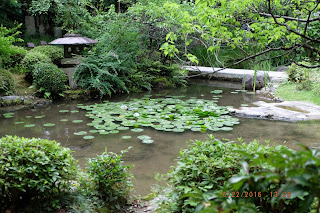Another amazing day. By the way, the rooms in Japan are tiny. They don't have much space to work with in this country, so everything is very small, roads, cars, houses. But they have amazing toilets.
Directions on how to use the toilet
If you have reached enlightenment, you should be able to see all 15 rocks sitting in the same location. I couldn't see them all.
Ryoanji Rock Garden
Next stop was Nijo Castle. This is the 1st official home of the 1st Tokugawa shogun, Tokugawa Ieyasu. It was started in 1603 and finished in 1626. It is an amazing example of the early Edo period architecture. It was quite grand with many reception areas for ministers, daimyo, and family. There were the original nightingale floors. These alert the inhabitants to intruders with a squeaking sound that supposedly sounds like birds.
Entrance to Nijo Castle
Underneath of nightingale floors that squeak to alert people to intruders.
The moat around the castle.
Lunch of course was beautiful as all food seems to be in Japan. Bento boxes for everyone.
We did a little shopping at the Kyoto Handicraft C`enter and I purchased two wood block prints from the Tokaido road. Next we were off to Kinaku-Ji (Golden Pavillion) Temple. Supposedly the Buddhist hall contains relics of Buddha. It was built around 1397 during the Muromachi period. The garden and buildings were said to represent Pure Land of Buddha in this world. It really was beautiful.
Some cute school kids.
One thing that has been really fun is how excited some of the Japanese school children have been to see us. It is the end of their school year and they are going on lots of field trip to the local temples and shrines. Some of them are very shy about having their pictures taken, but many of them are happy to be photographed. We have also seen lots of people wearing kimonos. Some are tourists, but many are Japanese people visiting the temples and shrines.
The last stop of the day was the Heinan Shrine. It is a beautiful Shinto shrine. Shinto is Japan's oldest religion. Many shrines are small neighborhood shrines that have a part time priests who has another job as well. Many Japanese observe Shinto as well as Buddhist practices. The Shinto practices mostly are around purification. Weddings in Shinto shrines are very popular in Japan. Buddhism is about reaching enlightenment. Most Buddhist temples have pagodas that are quite extraordinary. They are usually 3 or 5 stories and there is supposed to be a relic from the Buddha in each one.
You are supposed to walk through this large circle in a certain pattern as you pray.
Prayers
More prayers
Lots of women dress up in kimonos and take pictures in the gardens around the city.
A family taking pictures
After dinner, we visited the Gion district of Kyoto. That is across the river and is where the tea houses where the geishas entertained the Japanese men. There were also boarding houses where the geisha lived and trained. The training would take up to 5 years and was paid for by the boarding house owner. If a geisha decided to leave the trade, her parents would have to pay the boarding house owner back. Geisha were well trained in the singing, dancing, poetry, etc. There are still active tea houses today and we saw a true geisha as well as a geisha in training. Our guide Junko showed us how to determine whether the building were tea houses and boarding houses.
Tea House
2
Geisha boarding house
Directions on what to do and not to do.
Geiko walking to a tea house




























No comments:
Post a Comment